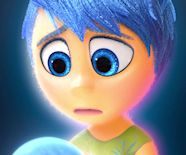11-year-old Riley and her family move from their home in Minnesota to San Francisco.
Riley leaves behind all her friends, and her beloved ice hockey.
It is an emotional time for her.
Like everyone else, Riley is guided/controlled by her five emotion homunculi:
Joy, Sadness, Disgust, Anger, and Fear.
The young Riley is mostly governed by Joy, and is a cheerful child.
But Joy has a hard time keeping her human happy after the move.
Then disaster strikes: an accident sucks Joy and Sadness out of headquarters,
and they become lost in long term memory.
Now Fear, Anger and Disgust are left in charge, and Riley turns into a surly brat.
Then it gets worse: in their attempt to help Riley,
the remaining emotions get locked out of their control panel, and now Riley can’t feel anything at all.
After a slow start with a lot of info-dumping about how the interior world works
(as a sort of cross between a child’s fairy tale and a cognitive neuroscience text),
things ramp up once Joy and Sadness are lost, and trying to get home.
The adventure is wildly imaginative, with memory stores, dream sequences, imaginary friends,
forgetting, the subconscious, abstraction, and trying to catch the train of thought.
In the end, Joy learns an important lesson about Sadness, becoming a more mature emotion,
and Riley grows up, as her homunculi’s control console is upgraded to parallel working.
At several points in the internal journey, Joy feels some Sadness of her own,
and also Fear (or at least Alarm). Embodied emotions having emotions!
Does this mean that Joy has five even smaller emotion homunculi in her own head?
My brain kept trying to infinitely regress at several points.
This passes the Bechdel test:
Joy and Sadness are female, and spend nearly all the time talking about Riley.
In the external world, Riley’s teacher is female (although I don’t believe she is named?),
and speaks to Riley, asking her to introduce herself;
also Riley video chats with her friend Meg back in Minnesota about their hockey team.
Yet there is a curious asymmetry here.
During the film we see inside three other human heads:
Riley’s mother and father, with more mature homunculi,
and briefly a boy of Riley’s age, whose juvenile homunculi are freaked by being close to a girl.
The end credits give us views into a few more people, a dog, and, hysterically, a cat.
All these other homunculi are the same sort as their “owners”:
five mature females guiding the mother,
five arguably less mature and somewhat stereotypical males for the father,
five young males for the boy, five very cat-like cats in the cat, and so on.
Yet in Riley, although Joy, Sadness and Disgust are female,
both Fear and Anger are portrayed as male.
If the film had a boy main character, would any of his emotions have been portrayed as female, I wonder?
Overall, after that slow start, this is a marvellously imaginative romp through a brain,
and it is interesting that the obligatory happy ending is one of growing up and
the realisation that Sadness is important.
For all my film reviews, see
my main website.




No comments:
Post a Comment